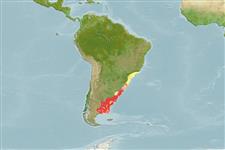Classificação / Names
Common names from other countries
Referência principal
Tamanho / Peso / Idade
Max length : 100.0 cm TL macho/indeterminado; (Ref. 27569); common length : 48.6 cm SL macho/indeterminado; (Ref. 27363); Peso máx. publicado: 10.0 kg (Ref. 27569)
Ambiente
; marinhas demersal; não migratória; intervalo de profundidade ? - 100 m (Ref. 53324)
Clima / Intervalo
Subtropical, preferred 13°C (Ref. 107945); 23°S - 48°S, 68°W - 41°W
Distribuição
Descrição breve
Espinhos dorsais (total): 4 - 5; Raios dorsais moles (total): 24-27; Espinhos anais 1; Raios anais moles: 22 - 24. Body pale brown with several dark brown vertical and horizontal stripes composed of dark brown blotches. A row of dark brown blotches on middle of dorsal fin membrane. An obvious black blotch on base of upper lobe of caudal fin (Ref. 27363).
Categoria na Lista Vermelha da IUCN (Ref. 115185)
Ameaça para o homem
Harmless
Utilização humana
Pescarias: espécies comerciais; peixe desportivo: sim
Mais informação
ReferênciasAquaculturaPerfil para aquaculturaEstirpesGenéticaFrequência dos alelosHereditariedadeDoençasProcessamentoMass conversion
ColaboradoresFotografiasStamps, CoinsSonsCiguateraVelocidadeTipo de nataçãoÁrea branquialOutras referênciasCérebrosVisão
Ferramentas
Relatórios especiais
Descarregue XML
Fontes da internet
Estimates of some properties based on models
Phylogenetic diversity index
PD50 = 0.7500 many relatives (e.g. carps) 0.5 - 2.0 few relatives (e.g. lungfishes)
Nível Trófico
3.9 ±0.68 se; Based on food items.
Resiliência
Baixo, tempo mínimo de duplicação da população 4,5 - 14 anos (Assuming tmax>10)
Vulnerabilidade
High to very high vulnerability (66 of 100)
Categoria de preço
